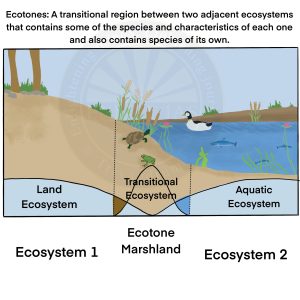What is it?
- An ecotone is a transitional area between two distinct ecological communities or ecosystems, where different habitats meet and integrate.
- These areas exhibit characteristics of both adjoining ecosystems and often contain unique species not found in the overlapping regions.

Features
- Biodiversity: Ecotones typically have higher biodiversity compared to the adjacent ecosystems due to the presence of species from both environments and some unique to the ecotone itself.
- Edge Effect: The phenomenon where increased biodiversity occurs at the boundary between two habitats, leading to more complex and diverse ecological interactions.
- Gradient: Ecotones often display a gradual change in environmental conditions, such as soil type, moisture levels, and vegetation, creating a gradient rather than a sharp boundary.
- Species Interactions: High levels of species interaction and competition due to the convergence of different species from adjoining habitats.
Examples
- Forest-Grassland Ecotone: The transitional area between a forest and a grassland, which may feature a mix of tree species and grassland flora.
- Riverbanks: The interface between terrestrial and aquatic ecosystems, where species from both land and water coexist and interact.
- Coastal Areas: The zone where marine and terrestrial ecosystems meet, often rich in biodiversity with unique species adapted to the changing environment.
Significance
- Biodiversity Hotspots: Serve as zones of high biodiversity and are critical for the conservation of many species.
- Ecological Indicators: Changes in ecotones can indicate broader environmental shifts or changes in ecosystem health.
- Habitat Connectivity: Facilitate movement and migration of species between ecosystems, aiding in genetic exchange and species dispersal.
- Buffer Zones: Act as buffer zones that mitigate the impact of disturbances in one ecosystem on the other.


